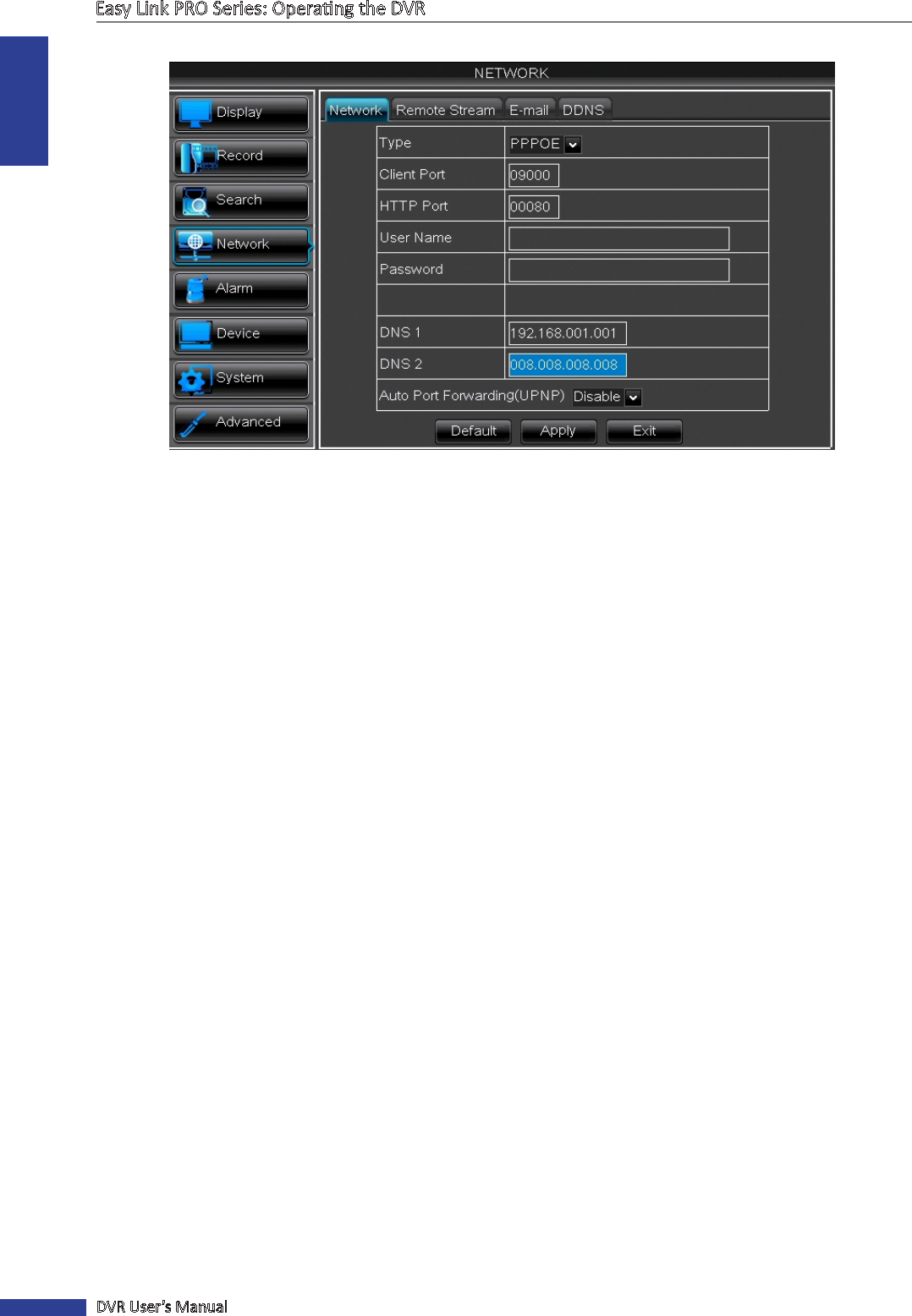User Manual
Table Of Contents
- About this Manual
- Quick Setup Guide
- Understanding the Live Viewing Screen
- Basic DVR Operation
- Accessibility Features
- Operating the DVR
- Main Menu
- Display: Live
- Display: Output
- Display: Privacy Zone
- Record: REC Para
- Record: Schedule
- Record: Record Setup
- Search: Record Search
- Search: Event Search
- Search: Log
- Network: Network
- Network: Remote Stream
- Network: Email
- Network: DDNS
- Alarm: Motion
- Device: HDD
- Device: PTZ
- Device: Cloud Storage
- System: General
- System: Users
- System: Info
- Advanced: Maintain
- Remote Access Via Web Client
- Appendix

ENGLISH
Easy Link PRO Series: Operang the DVR
70
DVR User’s Manual
PPPOE Connecon
• Type: Select the network type you are using.
DHCP Type: If you choose this type, then the network sengs will be lled automacally.
Stac Type: To ll in all the required network sengs, please ask your ISP (Internet Service Provider).
PPPoE Type: To ll in all the required network sengs, please ask your ISP (Internet Service Provider).
NOTE: If you are not sure in the network connecon type or in network sengs, always ask your ISP.
• Client Port: Is the port that the DVR will use to send informaon through. It is important to congure if you want
to use the UPnP feature (when your router supports UPnP, then you don’t need to manually forward ports from
the router to your DVR). The port must be unique. When you use the default port 9000, and it is already taken by
other devices or applicaons, please change the port and remember it because you need to use it when logging
in remotely to the DVR (Web Client). This seng is for advanced users.
• HTTP Port: Is the port that you will use to log in to the DVR (for example, using Web Client). The port must be
unique. When you use the default port 80, and it is already taken by other applicaons, please change the port,
for example, 85. In this case, you need to add the port number aer the IP address. For example, if you use Stac
IP address, you need to enter the IP address as “010.000.100.187:85” in the URL box when logging in Web Client.
• IP Address: The IP address idenes the DVR in the network. The IP address consists of four groups of numbers
between 0 to 255, separated by periods. For exapmle, “010.000.100.187”. If your network type is Stac, and you
are not sure what the IP address is, please ask your ISP.
• Subnet Mask: Subnet mask denes a range of IP addresses that can be used in a network. If IP address is like a
street where you live then subnet mask is like a neighborhood. The subnet address consists of four groups of
numbers, separated by periods. For example, “255.255.000.000”. If your network type is Stac and you are not
sure what the subnet mask address is, please ask your ISP.
• Gateway: This address allows the DVR to access the Internet. The format of the Gateway address is the same as
the IP Address has. For example, “010.000.000.254”. If your network type is Stac and you are not sure what the
Gateway is, please ask your ISP.
• DNS1/DNS2: DNS stands for Domain Name System where DNS1 is the main DNS server and DNS2 is the backup
server if the DNS1 is not accessible. DNS server sengs must be properly congured if you want to use the
E-mail nocaon, NTP or DDNS, etc. If you are not sure, what your DNS address is, please ask your ISP.
• Auto Port Forwarding (UPnP): If you want to access the Web Client remotely, you need to complete the port
forwarding. Enable this opon if your router supports the UPnP. You need to enable UPnP both, on DVR and
router. In this case you do not need to congure manually port forwarding on your router.
NOTE: If your router does not support UPnP, then make sure the port forwarding is completed manually. Please
see the customized free guide on hp://pororward.com/kguard.










